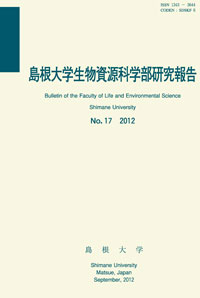島根大学生物資源科学部
ISSN:2435-0885(online)
ISSN:1343-3644(in print)
A publication of this bulletin in print format has not been made since no 24.
ISSN:1343-3644(in print)
A publication of this bulletin in print format has not been made since no 24.

number of downloads : ?
Use this link to cite this item : https://ir.lib.shimane-u.ac.jp/6934
Bulletin of the Faculty of Life and Environmental Science Shimane University 14
2009-09-30 発行
奥出雲町焼畑造林地における火入れ後の地上部バイオマスおよび土壌有機物の動態
Change s in aboveground biomass and soil organic matter following burning at the slash-and-burn sites in Nita, Shimane Prefecture
File
Description
We investigated the recovery processes of vegetation and dynamics of soil organic matter at the slash-and-burn sites. Foresters in Nita region of Shimane Prefecture conduct small-scale slash-and-burn forestry every year. They cultivated turnips at burnt sites during the first growing season and harvested them in the first winter. Seedlings of hinoki cypress were usually planted one year after burning.We set several quadrats at those slash-and-burn sites in 2007. According to our tree census, hinoki cypress trees grew well at the lower slopes. Litter decomposition rates estimated by the litter bag experiment were slow and almost constant at the upper slopes, but became faster with time after burning at the lower slopes. Litter layer accumulated more at the lower slopes than at the upper slopes irrespective of faster decomposition rates. Soil N mineralization decreased with time after burning. No N mineralization was detected in the soils ten years after burning both at the upper and lower slopes. Greater growth rate of hinoki cypress at the lower slopes might be due to greater litter accumulation and due to migration of soils from the upper slopes which can provide nutrients for trees.
About This Article
Other Article
